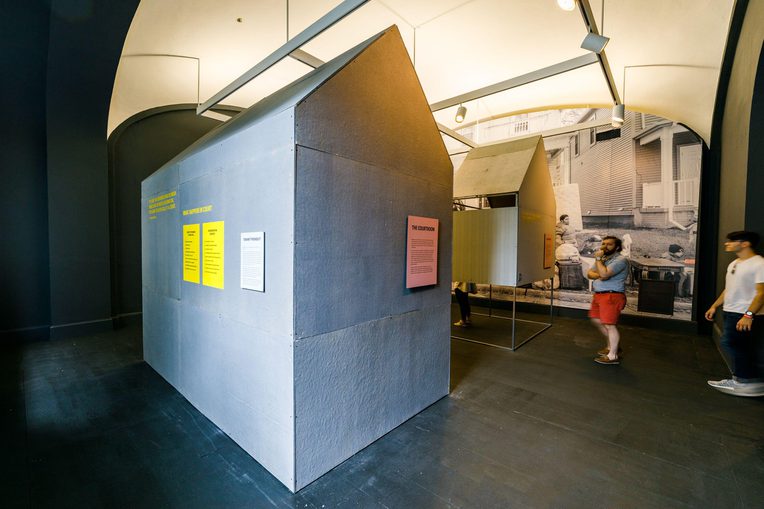
The glass doors to the Evicted exhibition at the National Building Museum open to a wall of eviction notices. The pink sheets of paper inform tenants that they have to leave in thirty days. Others give five-day notices. Some notify the tenants that they have a right to an attorney (but not to counsel). Notices to quit. Terminations of tenancy. These forms (these artifacts) that entangle state bureaucracies, courts, landlords, tenants—their children, their children’s schools, their communities, their places of work—accost visitors with their size and multitude. The exhibition's introductory text juts out from this tapestry of eviction notices: “There’s a knock on the door. Whether or not the belongings are packed, the kids are ready, or the new plan is in place, it no longer matters. The eviction has begun: it’s time to leave.”
The National Building Museum constructed Evicted in collaboration with Matthew Desmond, author of Evicted: Poverty and Profit in the American City. Based in Milwaukee but voicing the United States’ current housing crisis, this ethnography is the foundation and inspiration for the Evicted exhibition, which closed at the end of May 2019. The exhibition was intended to be “an immersive experience bringing our visitors into the world of low-income renter eviction,” and something that curator Sarah A. Leavitt says “situates visitors in a bleak scenario experienced by millions of Americans.” The exhibition's opening text certainly attempts this. Taken with the disquiet of being greeted by a wall of eviction notices, the passage elicits visceral feelings of precarity and anxiety.
In recent years, Washington, DC, has seen its fair share of immersive exhibits. Yayoi Kusama's 2017 Infinity Mirrors created the illusion of being suspended in darkness surrounded by dots of light. More recently, “Transaction Denied,” an art installation by Xena Ni and Mollie Rushkin at the pop-up gallery Umberlla14, created an enclosed space using Giant and Safeway receipts that showed attempts to pay for groceries using Supplement Nutrition Access Program benefits—attempts that failed due to a technical glitch. These examples raise the question of how outstretching and unconstrained phenomena and bureaucratic blunders with real, bodily consequences and harms, can be encapsulated and transformed into something in which a person can be immersed. What, then, does this mean for eviction, something that entails moving trucks, shelters, and the knowledge that calling the city because the landlord refuses to address hazardous conditions of the house puts the renter at decisive risk of being evicted in retaliation?
Desmond’s Evicted illustrates the entanglements that bind tenants and landlords together through the process of eviction. He focuses on the relationship between poverty and profit, in order to expose the deliberate, constructed, and contingent dimensions of extreme poverty. In this way, the book inverts the mainstream narrative that poverty leads to eviction, and shows, instead, how eviction leads to poverty. The flipping of this script lays the foundation for the core argument of the book: stable housing is critical to health—mental and physical—economic security, and the cultivation of community. Stable housing is thus the linchpin.
House-like structures stand in the first two rooms of the three-room exhibition. Their roofs aren’t quite finished. The walls, which appear to be made from thick card stock, reach neither to the floor nor to the roof, exposing the metal skeleton supporting the structure is exposed. In the houses, visitors can walk right up to the flatscreens projecting a montage of photos of people sitting surrounded by bills at the kitchen table or walking in the winter cold outside the doors of a homeless shelter, and the voices of those people telling the stories of their eviction/s occupy the space. Their voices provide a lens and narrative structure as visitors absorb the adjacent photos of movers emptying a home while the children who lived there look on; two men from the sheriff’s department confronting a woman on her lawn outside her home.

The positioning of these images and narratives, in conversation with their content, makes them especially compelling. The exhibition plays on multiple inversions of indexes of the public and private. The flatscreens inside the house-like structures project stories of being forced out. Many of the photos hung on the interior walls show houses being emptied of tenants’ belongings: front lawns filled with pink bed sheets and dressers, dining room sets, and family heirlooms; boxes stacked on top of a dresser and towering over a woman who is turned away from the camera. The house-like structures remain for the most part empty, filled only with images, infographics, and quotes from Desmond’s ethnography on the walls.
Wallpaper covers the house-like structures’ exteriors: gray stars glimmer on an even grayer background. Three wall hooks jut out from one exterior wall to which an unconnected light switch is fastened. These layered inversions of public and private, interior and exterior, do not so much signal matter out of place as they do how eviction unravels so many livelihoods.
And through these inversions, the exhibition uses the materiality of these "houses" to communicate the systemic, bureaucratic, and deliberate violence of eviction.
In the final months of the exhibition in Washington, DC, the National Building Museum hosted multiple conversations in collaboration with Discover Washington and the Interactivity Foundation. These dialogues centered on how to achieve landlord-tenant parity in court and how to confront eviction with compassionate action. As in many cities across the country, Washington, DC, faces a severe affordable housing crisis, 350,000—non-luxury—units would have to be constructed to satisfy the city’s housing needs. The exhibition's one-story tall outline of the United States, with boxes in sizes proportional to the number of evictions in cities across the country, shows that DC saw 27,434 evictions in DC in 2016. Often touted as a “tenant-friendly city”—where eviction takes several months and is prohibited in the winter—the exhibition calls into question what constitutes friendliness: a placard reads: “More than 40,000 households are on a waiting list for public housing and vouchers that has now been closed for several years...In this increasingly expensive, gentrifying city, there are not enough affordable housing units.” These realities render “tenant-friendly laws” inaccessible and inapplicable, particularly for racialized minorities in the District. In April 2019, Mayor Muriel Bowser proposed to dedicate twenty million dollars to the development of middle-income, working-class housing. Her proposal has been rightly criticized for its silence and neglect regarding the housing needs of the city’s lowest-income residents, who are rapidly being pushed out by luxury development.

It is fitting that the exhibition closes with these conversations on housing inequality. Evicted aims to both initiate conversation on the housing crisis in the United States, and to express solidarity with and recognition for those caught amid social and economic insecurity. After walking through these house-like structures whose many inversions and representations of space aim to unsettle viewers, the final room offers respite: a sofa and coffee table, bright walls rather than the hues of gray, and another expansive map. This one visualizes histories of advocacy and activism: the battle for the I-Hotel in San Francisco in 1977, the great rent wars in 1919 New York City, and #OurHomesOurVoices in 2018 Washington, DC, among others. Here, respite and action coincide and become constitutive of one another. Evicted is a call to compassionate activism.
The exhibition opened in Milwaukee, WI, June 2019 at the University of Wisconsin-Milwaukee School of Architecture & Urban Planning Mobile Design Box. You can see if the exhibition is traveling to a museum near you and get information about hosting the exhibit at https://www.nbm.org/national-building-museum-exhibition-evicted-will-travel-across-the-country/.
References
Desmond, Matthew. 2016. Evicted: Poverty and Profit in the American City. New York: Crown Publishing Group.